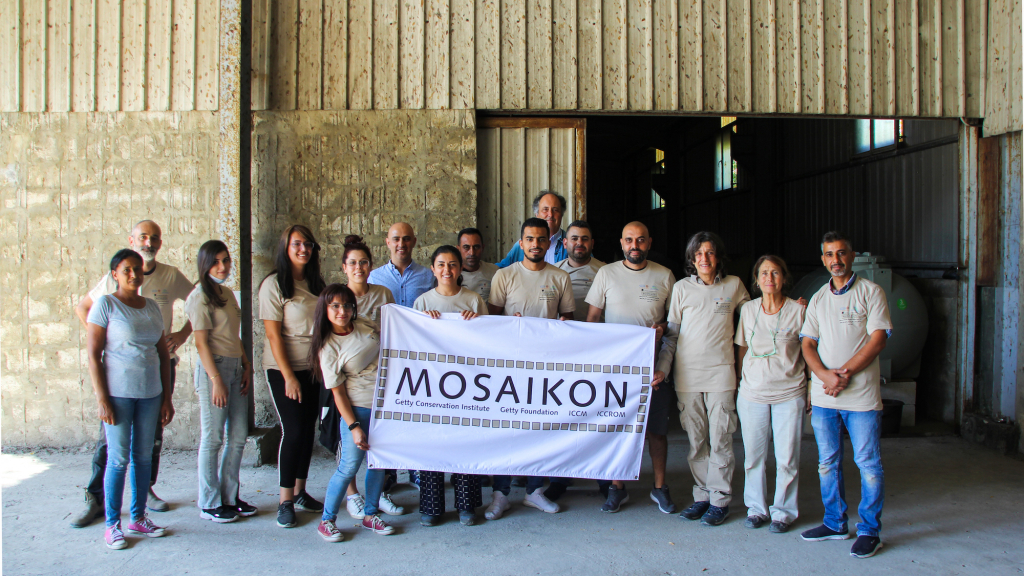The MOSAIKON course in Sidon assembled mosaic conservation trainees to tackle the long-term preservation of mosaics in storage
 MOSAIKON participants in Sidon, Lebanon
MOSAIKON participants in Sidon, LebanonThe Directorate General of Antiquities of Lebanon (DGA), Getty Conservation Institute (GCI) and the International Centre for the Study of the Preservation and Restoration of Cultural Property (ICCROM) through its Sharjah Regional Office have announced the conclusion of a four-week course in Sidon, Lebanon. The “MOSAIKON Training Worksite for the Conservation of Mosaics in Storage” took place from 10 October to 4 November 2022.
A closing ceremony on 4 November 2022 celebrated the completion of the training, one of the final courses of MOSAIKON, a 14-year initiative in collaboration with the GCI, the Getty Foundation, ICCROM and the International Committee for the Conservation of Mosaics (ICCM). Since 2008, MOSAIKON has trained over 200 individuals in mosaic conservation from countries of the southern and eastern Mediterranean region.
At the beginning of the closing ceremony, the working group discussed the results of the questionnaire in which the trainees were evaluated and the extent to which they acquired practical skills and theoretical principles for preserving mosaics in storage. Dr Aicha ben Abed, a coordinator of MOSAIKON, gave a lecture on the history of mosaics in the Mediterranean basin, explaining its importance, types and forms. At the conclusion of the ceremony Architect Sarkis El Khoury, Director General of Antiquities in Lebanon, and Dr Zaki Aslan, Regional Representative of ICCROM for the Arab States and Director of the ICCROM-Sharjah Office in the UAE, visited the training site and viewed the mosaic fragments that were stabilized and re-backed and the storage structure that was maintained. Then, Architect El Khoury and Dr Aslan, in the presence of Livia Alberti and Cristina Caldi from the GCI, distributed participation certificates to the trainees, praised their efforts and stressed the importance of following up on the mosaic restoration work and building national capacities in the conservation of mosaics.
“It was a great pleasure for the Ministry of Culture - Directorate General of Antiquities to organize this training with its partners, especially after the tremendous challenges encountered during the last couple of years,” said Architect El Khoury. “The fragile conservation state of the mosaics in Sidon storage led us to develop simple, inexpensive and sustainable treatment methodologies for their long-term storage in accordance with Lebanon’s needs.”
“For over a decade, ICCROM has had the privilege of working with committed partners and outstanding participants of the MOSAIKON initiative," said Webber Ndoro, ICCROM's Director-General. "We are pleased to see this continue as we cultivate future leaders in efforts to conserve mosaic heritage.”
Threats to mosaic conservation include new construction, looting and a lack of trained professionals for managing ongoing maintenance needs. The course convened eight DGA employees and two government employees from Jordan to enhance the capacity of authorities in these countries to conserve their mosaic heritage.
Trainees learned through practical experience a different methodology for documenting and conserving lifted mosaics using lime mortars to stabilize and re-back them, along with preventive measures to store them long-term.
“It was an honor to hold this course in Lebanon, one of the first countries where we originally began the MOSAIKON initiative,” said Thomas Roby, senior project specialist at GCI. “We are confident course participants will utilize the knowledge and hands-on experience gained during the training worksite to continue protecting vulnerable archaeological heritage in the region for years to come as well as mentor future mosaic conservation professionals to continue this important work.”
Practical exercises were conducted with participants using examples from a large collection of lifted mosaics from downtown Beirut that have been stored in Sidon without any backing since 1998. After assessing their poor conditions, the urgent work to provide mortar backings and remove the deteriorated facings used to lift them decades earlier was carried out on one mosaic fragment. The supervised operations by the trainees ended with the fragment being moved to a prototype metal storage shelving unit for its long-term survival. With the skills and knowledge gained from this experience, the multi-year task of conserving the entire collection of mosaics of Ancient Beirut can finally begin in the purpose-built storage facility after 25 years.
“We are honored to have been ICCROM’s focal point for the MOSAIKON initiative since its inception with committed partners in 2008. It’s fulfilling to culminate a decade of work with Mediterranean countries addressing often-neglected, hidden areas of storage with significant mosaics, such as the ones uncovered in Central Beirut in the 1990s,” said Dr Zaki Aslan. “These and similar art pieces remain testimonies for future generations, people and researchers to learn from and enjoy, and deserve continued efforts to preserve them by adopting methodological approaches that future leaders who took part in MOSAIKON courses will undoubtedly further disseminate.”
While the completion of the Sidon course is among the final MOSAIKON activities, partners in the initiative will continue commitments to its long-term goal of preserving ancient mosaics throughout the Mediterranean basin.
Another final MOSAIKON course for lifted mosaics will take place in Byblos, Lebanon, in late November by the Lebanon Ministry of Culture - Directorate General of Antiquities (DGA).
